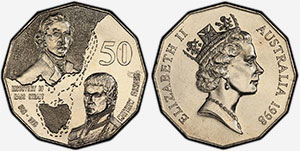50 cents 1998 - Bass and Flinders
By CAA | Thursday, 19 October 2023
Bass and Flinders were the explorers who proved that Tasmania (Van Diemen's Land) was an island, separated from the mainland of Australia. The 50 cents 1998 circulating coin was released to commemorate the 200th anniversary of the 1798 voyage of Bass and Flinders.
The design depicts the road traveled that year by both navigators, which are also shown on the reverse.
Specifications
- Edge: Plain
- Weight: 15.55 grams (240.0 grains)
- Diameter: 31.5 mm
- Composition: 75% Copper, 25% Nickel
- Obverse: Queen Elizabeth II, design by Raphael Maklouf.
Legend: ELIZABETH. II. AUSTRALIA 1998 - Reverse: Bass & Flinders over Map, design by Vladimir Gottwald.
Legend: DISCOVERY OF BASS STRAIT - GEORGE BASS - MATTHEW FLINDERS - Mintage: 22,389,200
Matthew Flinders
Matthew Flinders was also born in Lincolnshire, in 1774, and was the son of Matthew Flinders, a surgeon. In February 1792, he arrived at Adventure Bay in the south of what is now called Tasmania. The officers and crew spent over a week in the region obtaining water and lumber, and interacting with local Aboriginal people. This was Flinders' first direct association with the Australian continent.
Flinders' desire for adventure led him to enlist as a midshipman aboard HMS Reliance in 1795. This vessel was headed to New South Wales carrying the recently appointed governor of that British colony, Captain John Hunter. On this voyage Flinders, became friends with the ship's surgeon George Bass.
George Bass
Bass was born on January 30, 1771 in Lincolnshire. At the age of 18, Bass was accepted in London as a member of the Company of Surgeons, and in 1794 he joined the Royal Navy as a surgeon. He arrived in Sydney in New South Wales September 7, 1795.
Circumnavigation
Van Diemen's Land (Tasmania)
In 1798, Matthew Flinders, now a lieutenant, was given command of the sloop Norfolk with orders "to sail beyond Furneaux's Islands, and, should a strait be found, pass through it, and return by the south end of Van Diemen's Land". Flinders and Bass had in the months previously both made separate journeys exploring the region but neither were conclusive toward the existence of a strait.
Flinders, with Bass and several crewmen, sailed the Norfolk along the uncharted northern and western coasts of Van Diemen's Land, rounded Cape Pillar and returned to Furneaux's Islands. By doing so, Flinders had completed the circumnavigation of Van Diemen's Land and confirmed the presence of a strait between it and the mainland. The passage was named Bass Strait after his close friend, and the largest island in the strait would later be named Flinders Island in his honour.
Terra Australis (Australia)
Flinders set sail again on July 22, 1802 to 1803 around the continent. He is credited as being the first person to utilise the name Australia to describe the entirety of it including Van Diemen's Land.
Other Bass & Flinders releases
This coin was also included as part of two 6 coin proof sets (Normal and Baby) and two 6 coin mint sets (Normal and Baby) released by the Canberra mint. Baby sets were designed specifically to be given as a gift upon the birth of a child. One side of the medallion including in them was blank to enable a child's name to be engraved.
A further 1,000 proof coins were included in a 5 Note, 6 Coin portfolio released by Note Printing Australia.
Specimen quality versions of the coin were included in First Day Cover packs jointly issued with Australia Post.
Uncirculated versions were included in 1,000 Spirit of Discovery Bass & Flinders Commemorative sets issued at the ANDA Coin Show in Sydney during October, 1998 and in unofficial 1966-98 10 Coin Fifty Cent Commemorative sets issued by various Australian coin dealers.
Banknotes
The death of King George VI presented an opportunity to introduce new designs for the 10 shillings note in 1954. Captain Matthew Flinders is featured on the front of the new note and the then Parliament House in Canberra appears on the back.
50 cents 1998 price guide and values









